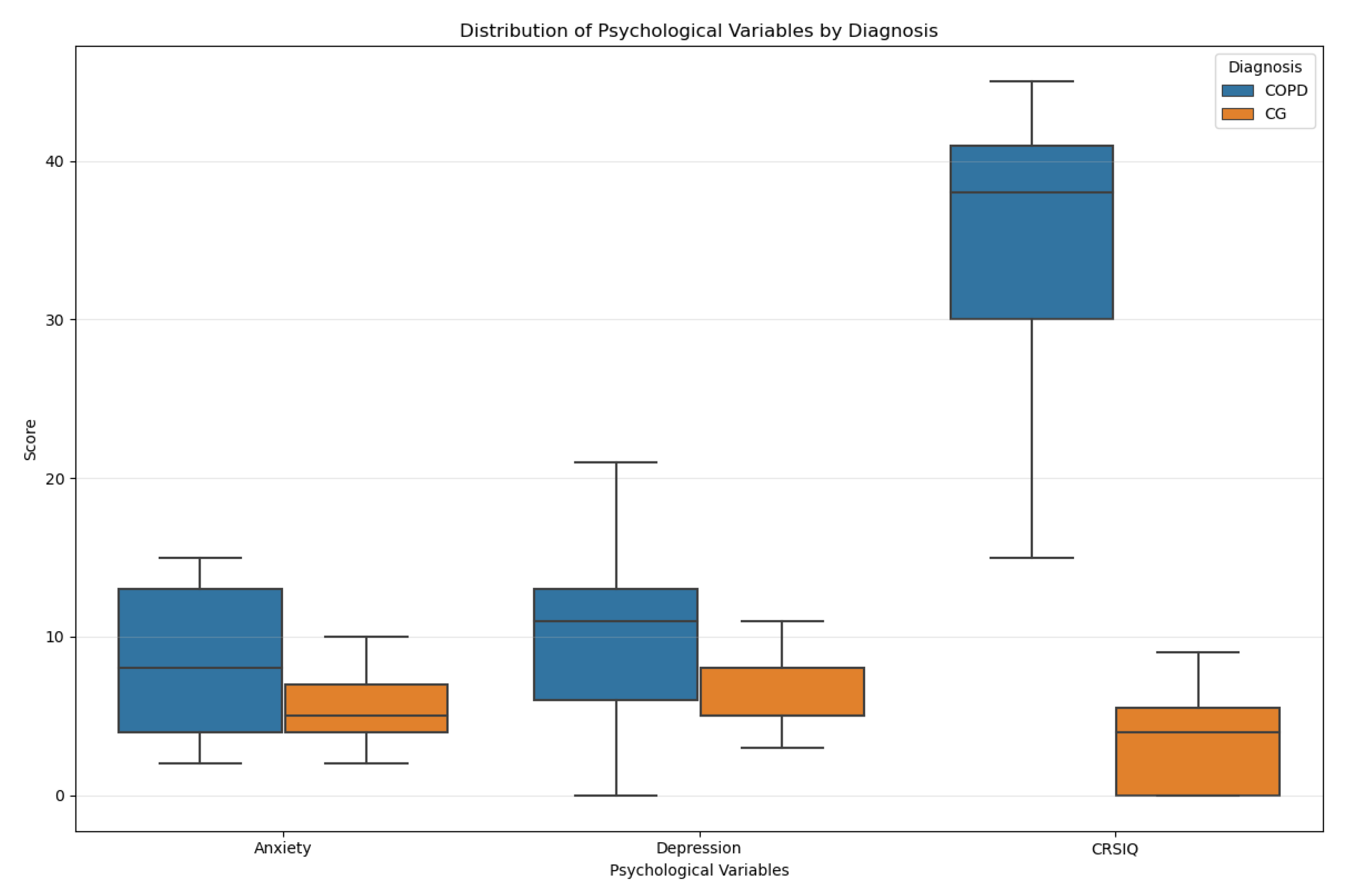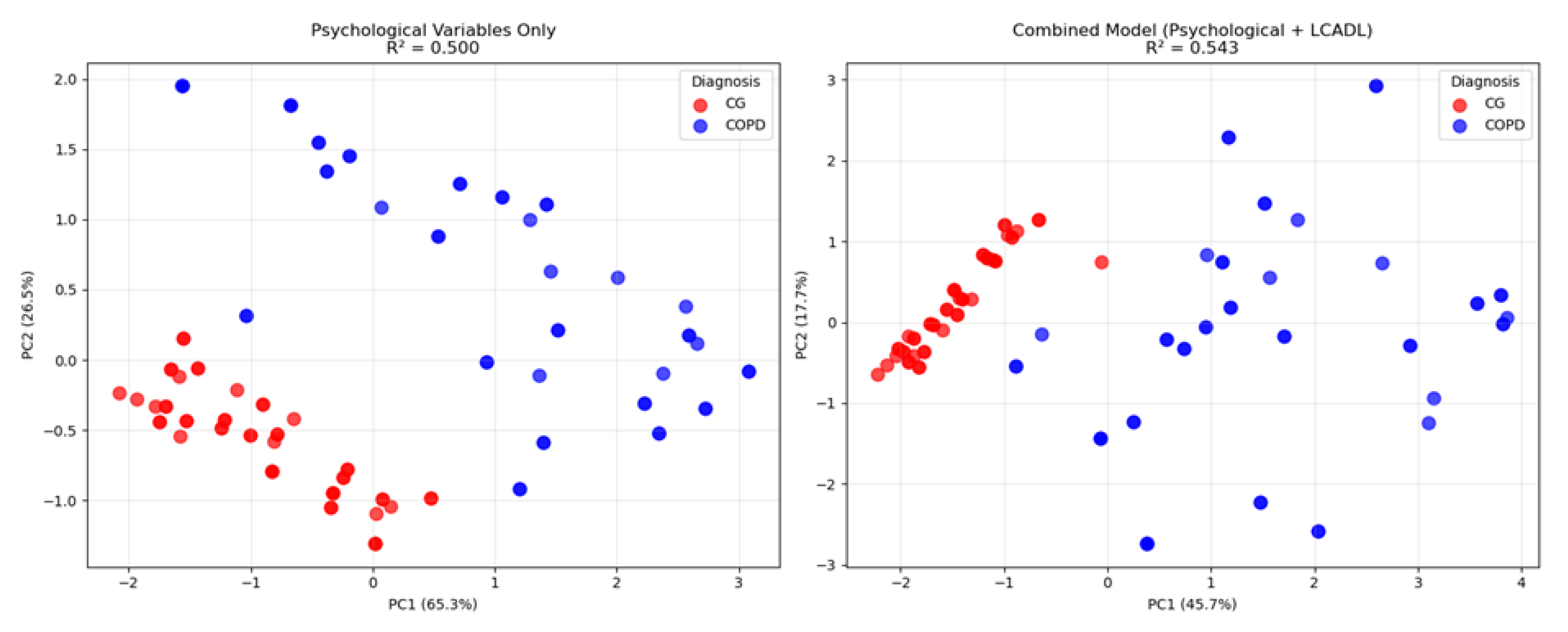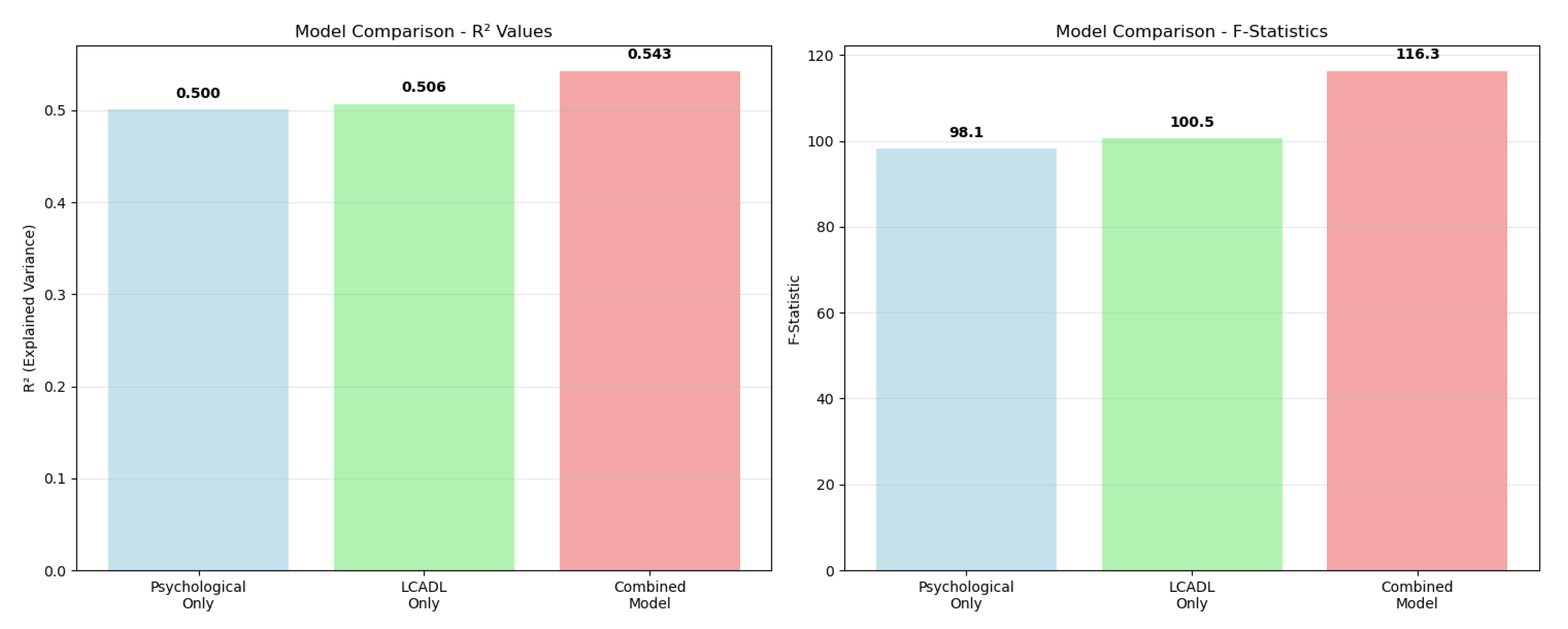Investigating the Impact of Body Composition Analysis on Quality of Life and Anxiety–Depression in Adult Males with Chronic Obstructive Pulmonary Disease
Abstract
1. Introduction
2. Materials and Methods
2.1. Study Design and Participants
2.2. Study Procedure
2.2.1. Pulmonary Function Tests
2.2.2. Medical Research Council (MRC) Dyspnea Scale
2.2.3. London Chest Activity of Daily Living Scale (LCADL)
2.2.4. Hospital Anxiety and Depression Scale (HAD)
2.2.5. Borg Fatigue Scale
2.2.6. Tanita Body-Fat Analysis (Bioelectrical Impedance Analysis (BIA))
2.2.7. Chronic Respiratory System Issues Questionnaire (CRSIQ)
2.3. Statistical Data Analysis
3. Results
4. Discussion
5. Conclusions
Author Contributions
Funding
Institutional Review Board Statement
Informed Consent Statement
Data Availability Statement
Acknowledgments
Conflicts of Interest
Abbreviations
| GOLD | Global Initiative for Chronic Obstructive Lung Disease |
| COPD | Chronic Obstructive Pulmonary Disease |
| PFT | Pulmonary Function Tests |
| PEF | Peak Expiratory Flow |
| MRC | Medical Research Council |
| MVV | Maximum Voluntary Ventilation |
| FEV1 | Forced Expiratory volume in minute |
References
- Rajul, K.; Jain, A.; Dutta, P.; Shrikhande, A.; Pandey, C.; Pathak, J. Comparison of Serum CRP, Total Cholesterol, Magnesium and Uric Acid in Smoker and Non Smoker Patients with COPD: A Cross-Sectional Study. J. Clin. Diagn. Res. 2023, 17, 6. [Google Scholar] [CrossRef]
- Karlsen, J.H.; Jørgensen, K.H.; Weinreich, U.M. Association between Impairment of Lung Function and Risk of Anxiety and Depression in Patients with Chronic Obstructive Pulmonary Disease—A Systematic Review. Syst. Rev. 2024, 13, 300. [Google Scholar] [CrossRef] [PubMed]
- Genç, A.; Üçok, K.; Şener, Ü.; Koyuncu, T.; Akar, O.; Çelik, S.; Ünlü, M. Association Analyses of Oxidative Stress, Aerobic Capacity, Daily Physical Activity, and Body Composition Parameters in Patients with Mild to Moderate COPD. Turk. J. Med. Sci. 2014, 44, 972–979. [Google Scholar] [CrossRef] [PubMed]
- Silverman, E.K.; Weiss, S.T.; Drazen, J.M.; Chapman, H.A.; Carey, V.; Cambell, E.J.; Denish, P.; Silverman, R.A.; Celedon, J.C.; Reilly, J.J.; et al. Gender-Related Differences in Severe, Early-Onset Chronic Obstructive Pulmonary Disease. Am. J. Respir. Crit. Care Med. 2000, 162, 2152–2158. [Google Scholar] [CrossRef]
- Spruit, M.A.; Pitta, F.; McAuley, E.; ZuWallack, R.L.; Nici, L. Pulmonary Rehabilitation and Physical Activity in Patients with Chronic Obstructive Pulmonary Disease. Am. J. Respir. Crit. Care Med. 2015, 192, 924–933. [Google Scholar] [CrossRef]
- Schols, A.M.W.J.; Wouters, E.F.M. Nutritional Abnormalities and Supplementation in Chronic Obstructive Pulmonary Disease. Clin. Chest Med. 2000, 21, 753–762. [Google Scholar] [CrossRef]
- King, D.A.; Cordova, F.; Scharf, S.M. Nutritional Aspects of Chronic Obstructive Pulmonary Disease. Proc. Am. Thorac. Soc. 2008, 5, 519–523. [Google Scholar] [CrossRef]
- Shoup, R.; Dalsky, G.; Warner, S.; Davies, M.; Connors, M.; Khan, M.; Khan, F.; ZuWallack, R. Body Composition and Health-Related Quality of Life in Patients with Obstructive Airways Disease. Eur. Respir. J. 1997, 10, 1576–1580. [Google Scholar] [CrossRef]
- Seymour, J.M.; Spruit, M.A.; Hopkinson, N.S.; Natanek, S.A.; Man, W.D.-C.; Jackson, A.; Gosker, H.R.; Schols, A.M.W.J.; Moxham, J.; Polkey, M.I.; et al. The Prevalence of Quadriceps Weakness in COPD and the Relationship with Disease Severity. Eur. Respir. J. 2010, 36, 81–88. [Google Scholar] [CrossRef]
- Engelen, M.P.; Schols, A.M.; Heidendal, G.A.; Wouters, E.F. Dual-Energy X-Ray Absorptiometry in the Clinical Evaluation of Body Composition and Bone Mineral Density in Patients with Chronic Obstructive Pulmonary Disease. Am. J. Clin. Nutr. 1998, 68, 1298–1303. [Google Scholar] [CrossRef]
- Franssen, F.M.E. Sarcopenia in COPD: Functional and Metabolic Implications. Doctoral Thesis, Maastricht University, Maastricht, The Netherlands, 2009. [Google Scholar]
- Annegarn, J.; Meijer, K.; Passos, V.L.; Stute, K.; Wiechert, J.; Savelberg, H.H.C.M.; Schols, A.M.W.J.; Wouters, E.F.M.; Spruit, M.A. Problematic Activities of Daily Life Are Weakly Associated With Clinical Characteristics in COPD. J. Am. Med. Dir. Assoc. 2012, 13, 284–290. [Google Scholar] [CrossRef] [PubMed]
- Zheng, H.; Sun, W.; Zhou, Z.; Tian, F.; Xiao, W.; Zheng, L. Cut-off Points for Knee Extension Strength: Identifying Muscle Weakness in Older Adults. Eur. Geriatr. Med. 2024, 15, 913–925. [Google Scholar] [CrossRef]
- Miranda Alatriste, P.V.; Ramírez, E.C.; Carsi, X.A.; Cruz-Rivera, C.; Espinosa-Cuevas, Á. Hydration Status According to Impedance Vectors and Its Association with Clinical and Biochemical Outcomes and Mortality in Patients with Chronic Kidney Disease. Nutr. Hosp. 2022, 39, 1037–1046. [Google Scholar] [CrossRef] [PubMed]
- Pérez-Ros, P.; Barrachina-Igual, J.; Pablos, A.; Fonfria-Vivas, R.; Cauli, O.; Martínez-Arnau, F.M. Diagnostic Accuracy of Isometric Knee Extension Strength as a Sarcopenia Criteria in Older Women. BMC Geriatr. 2024, 24, 988. [Google Scholar] [CrossRef] [PubMed]
- Forrester, J.E.; Sheehan, H.M.B.; Joffe, T.H. A Validation Study of Body Composition by Bioelectrical Impedance Analysis in Human Immunodeficiency Virus (HIV)-Positive and HIV-Negative Hispanic Men and Women. J. Am. Diet. Assoc. 2008, 108, 534–538. [Google Scholar] [CrossRef]
- Löllgen, H.; Leyk, D. Exercise Testing in Sports Medicine. Dtsch. Arztebl. Int. 2018, 115, 409. [Google Scholar] [CrossRef]
- Going, S.; Massett, M.; Hall, M.; Bare, L.; Root, P.; Williams, D.; Lohman, T. Detection of Small Changes in Body Composition by Dual-Energy x-Ray Absorptiometry. Am. J. Clin. Nutr. 1993, 57, 845–850. [Google Scholar] [CrossRef]
- Agustí, A.G.N.; Noguera, A.; Sauleda, J.; Sala, E.; Pons, J.; Busquets, X. Systemic Effects of Chronic Obstructive Pulmonary Disease. Eur. Respir. J. 2003, 21, 347–360. [Google Scholar] [CrossRef]
- Correa, G.P.; Oliveira, C.C.; Vieira, G.C.; Cabral, L.F.; Malaguti, C.; José, A. Validity of the Functional Assessment of Chronic Illness Therapy Fatigue Scale (FACIT-F) in Individuals with Chronic Obstructive Pulmonary Disease in Brazil. Fisioter. Pesqui. 2024, 31, e23001924en. [Google Scholar] [CrossRef]
- Rahi, M.S.; Thilagar, B.; Balaji, S.; Prabhakaran, S.Y.; Mudgal, M.; Rajoo, S.; Yella, P.R.; Satija, P.; Zagorulko, A.; Gunasekaran, K. The Impact of Anxiety and Depression in Chronic Obstructive Pulmonary Disease. Adv. Respir. Med. 2023, 91, 123–134. [Google Scholar] [CrossRef]
- Willgoss, T.G.; Yohannes, A.M. Anxiety Disorders in Patients With COPD: A Systematic Review. Respir. Care 2013, 58, 858–866. [Google Scholar] [CrossRef] [PubMed]
- Maurer, J.; Rebbapragada, V.; Borson, S.; Goldstein, R.; Kunik, M.E.; Yohannes, A.M.; Hanania, N.A. Anxiety and Depression in COPD. Chest 2008, 134, 43S–56S. [Google Scholar] [CrossRef] [PubMed]
- Jiang, J.; Kwok, S.Y.C.L.; Deng, X. Effects of Social Mistreatment, Academic Alienation, and Developmental Challenge on University Students’ Well-being through Coping Strategies: A Longitudinal Study. Br. J. Educ. Psychol. 2025, 95, 464–479. [Google Scholar] [CrossRef] [PubMed]
- Ozbulut, O.; Genc, A.; Bagcioglu, E.; Coskun, K.S.; Acar, T.; Alkoc, O.A.; Karabacak, H.; Sener, U.; Ucok, K. Evaluation of Physical Fitness Parameters in Patients with Schizophrenia. Psychiatry Res. 2013, 210, 806–811. [Google Scholar] [CrossRef]
- Williams, N. The MRC Breathlessness Scale. Occup. Med. 2017, 67, 496–497. [Google Scholar] [CrossRef]
- Garrod, R.; Bestall, J.C.; Paul, E.A.; Wedzicha, J.A.; Jones, P.W. Development and Validation of a Standardized Measure of Activity of Daily Living in Patients with Severe COPD: The London Chest Activity of Daily Living Scale (LCADL). Respir. Med. 2000, 94, 589–596. [Google Scholar] [CrossRef]
- Cox, J.; Matthews, H.; Browne, P.; Blackburn, A. Comparison of Respiratory-Related Quality of Life Pulmonary Rehabilitation Outcomes and Duration of Treatment in Acute and Community Settings. Thorax 2013, 68, A127.2–A128. [Google Scholar] [CrossRef]
- Cohen, J. Statistical Power Analysis for the Behavioral Sciences, 2nd ed.; Lawrence Erlbaum Associates: Hillsdale, NJ, USA, 1988; pp. 77–83. [Google Scholar]
- Park, C.-H.; Yi, Y.; Do, J.G.; Lee, Y.-T.; Yoon, K.J. Relationship between Skeletal Muscle Mass and Lung Function in Korean Adults without Clinically Apparent Lung Disease. Medicine 2018, 97, e12281. [Google Scholar] [CrossRef]
- Fekete, M.; Szarvas, Z.; Feher, A.; Lehoczki, A.; Varga, J.T. Assessment of Nutritional Status and Body Composition in Relation to Quality of Life in COPD Patients. Eur. Respir. J. 2022, 60, 1238. [Google Scholar] [CrossRef]
- Chua, J.R.; Albay, A.B., Jr.; Tee, M.L. Body Composition of Filipino Chronic Obstructive Pulmonary Disease (COPD) Patients in Relation to Their Lung Function, Exercise Capacity and Quality of Life. Int. J. Chron. Obs. Pulmon Dis. 2019, 14, 2759–2765. [Google Scholar] [CrossRef]
- Gosker, H.R.; van Mameren, H.; van Dijk, P.J.; Engelen, M.P.K.J.; van der Vusse, G.J.; Wouters, E.F.M.; Schols, A.M.W.J. Skeletal Muscle Fibre-Type Shifting and Metabolic Profile in Patients with Chronic Obstructive Pulmonary Disease. Eur. Respir. J. 2002, 19, 617–625. [Google Scholar] [CrossRef] [PubMed]
- Ovsyannikov, E.; Budnevsky, A.; Titova, L.; Ivanova, A.; Kachur, A. The Peculiarities of Six-Minute Walk Test in Patients with Chronic Obstructive Pulmonary Disease, Some with Normal Weight and Some Overweight. Int. J. Biomed. 2022, 12, 530–534. [Google Scholar] [CrossRef]
- Kwan, H.Y.; Maddocks, M.; Nolan, C.M.; Jones, S.E.; Patel, S.; Barker, R.E.; Kon, S.S.C.; Polkey, M.I.; Cullinan, P.; Man, W.D.-C. The Prognostic Significance of Weight Loss in Chronic Obstructive Pulmonary Disease-related Cachexia: A Prospective Cohort Study. J. Cachexia Sarcopenia Muscle 2019, 10, 1330–1338. [Google Scholar] [CrossRef] [PubMed]
- Orea-Tejeda, A.; Gómez-Martínez, M.; González-Islas, D.; Flores-Cisneros, L.; Keirns-Davis, C.; Sánchez-Santillán, R.; Pérez-García, I.; Martínez-Luna, N.; Robles-Hernández, R.; Sánchez-Moreno, C.; et al. The Impact of Hydration Status and Fluid Distribution on Pulmonary Function in COPD Patients. Sci. Rep. 2022, 12, 1216. [Google Scholar] [CrossRef]
- Santanasto, A.J.; Glynn, N.W.; Newman, M.A.; Taylor, C.A.; Brooks, M.M.; Goodpaster, B.H.; Newman, A.B. Impact of Weight Loss on Physical Function with Changes in Strength, Muscle Mass, and Muscle Fat Infiltration in Overweight to Moderately Obese Older Adults: A Randomized Clinical Trial. J. Obes. 2011, 2011, 1–10. [Google Scholar] [CrossRef]
- Hurst, C.; Robinson, S.M.; Witham, M.D.; Dodds, R.M.; Granic, A.; Buckland, C.; De Biase, S.; Finnegan, S.; Rochester, L.; Skelton, D.A.; et al. Resistance Exercise as a Treatment for Sarcopenia: Prescription and Delivery. Age Ageing 2022, 51, afac003. [Google Scholar] [CrossRef]
- Vagaggini, B.; Taccola, M.; Severino, S.; Marcello, M.; Antonelli, S.; Brogi, S.; De Simone, C.; Giardina, A.; Paggiaro, P.L. Shuttle Walking Test and 6-Minute Walking Test Induce a Similar Cardiorespiratory Performance in Patients Recovering from an Acute Exacerbation of Chronic Obstructive Pulmonary Disease. Respiration 2003, 70, 579–584. [Google Scholar] [CrossRef]
- Çiftçi, R.; Kurtoğlu, A.; Eken, Ö.; Durmaz, D.; Eler, S.; Eler, N.; Aldhahi, M.I. Investigation of Factors Affecting Shuttle Walking Performance at Increased Speed for Patients with Chronic Obstructive Pulmonary Disease. J. Clin. Med. 2023, 12, 4752. [Google Scholar] [CrossRef]
- Yang, I.A.; Jenkins, C.R.; Salvi, S.S. Chronic Obstructive Pulmonary Disease in Never-Smokers: Risk Factors, Pathogenesis, and Implications for Prevention and Treatment. Lancet Respir. Med. 2022, 10, 497–511. [Google Scholar] [CrossRef]
- Munhoz da Rocha Lemos Costa, T.; Costa, F.M.; Jonasson, T.H.; Moreira, C.A.; Boguszewski, C.L.; Borba, V.Z.C. Body Composition and Sarcopenia in Patients with Chronic Obstructive Pulmonary Disease. Endocrine 2018, 60, 95–102. [Google Scholar] [CrossRef]
- Neale, C.D.; Christensen, P.E.; Dall, C.; Ulrik, C.S.; Godtfredsen, N.; Hansen, H. Sleep Quality and Self-Reported Symptoms of Anxiety and Depression Are Associated with Physical Activity in Patients with Severe COPD. Int. J. Environ. Res. Public Health 2022, 19, 16804. [Google Scholar] [CrossRef] [PubMed]
- Eker, S.; Ayaz, L.; Tamer, L.; Ulubaş, B. Leptin, Visfatin, Insulin Resistance, and Body Composition Change in Chronic Obstructive Pulmonary Disease. Scand. J. Clin. Lab. Investig. 2010, 70, 40–44. [Google Scholar] [CrossRef] [PubMed]
- Almeida Gulart, A.; de Araujo, C.L.P.; Bauer Munari, A.; Schneider, B.F.; Dal Lago, P.; Mayer, A.F. Minimal Important Difference for London Chest Activity of Daily Living Scale in Patients with Chronic Obstructive Pulmonary Disease. Physiotherapy 2020, 107, 28–35. [Google Scholar] [CrossRef] [PubMed]
- Schünemann, H.J.; Puhan, M.; Goldstein, R.; Jaeschke, R.; Guyatt, G.H. Measurement Properties and Interpretability of the Chronic Respiratory Disease Questionnaire (CRQ). COPD J. Chronic Obstr. Pulm. Dis. 2005, 2, 81–89. [Google Scholar] [CrossRef]



| Variables | CG | COPD | p-Value | |
|---|---|---|---|---|
| n (%) | n (%) | |||
| Gender | Male | 51 (100) | 49 (100) | <0.001 ** |
| Cough | There is | 0 (0) | 41 (83.67) | <0.001 ** |
| None | 51 (100) | 8 (16.33) | ||
| Sputum | There is | 0 (0.00) | 43 (87.76) | <0.001 ** |
| None | 51 (100.00) | 6 (12.24) | ||
| Grunt | There is | 0 (0.00) | 43 (87.76) | <0.001 ** |
| None | 51 (100.00) | 6 (12.24) | ||
| Cigarette | There is | 4 (7.84) | 16 (32.65) | <0.001 * |
| None | 39 (76.47) | 0 (0.00) | ||
| He left | 8 (15.69) | 33 (67.35) | ||
| MRC | Dyspnea: None | 50 (98.04) | 0 (0.00) | <0.001 * |
| Mild dyspnea | 0 (0.00) | 4 (8.16) | ||
| Moderate Dyspnea | 1 (1.96) | 14 (28.57) | ||
| Severe Dyspnea | 0 (0.00) | 26 (53.06) | ||
| Very Severe | 0 (0.00) | 5 (10.20) | ||
| Variables | CG | COPD | p-Value | |
|---|---|---|---|---|
| n (%) | n (%) | |||
| Personal Care | Does not attract | 51 (100) | 25 (51.02) | <0.001 ** |
| It’s pulling. | 0 (0) | 24 (48.98) | ||
| Homework | Does not attract | 51 (100) | 47 (95.92) | 0.238 *** |
| It’s pulling. | 0 (0) | 2 (4.08) | ||
| Physically | Does not attract | 50 (98.04) | 8 (16.33) | <0.001 ** |
| It’s pulling. | 1 (1.96) | 41 (83.67) | ||
| Spare time | Does not attract | 51 (100) | 27 (63.27) | <0.001 ** |
| Variables | Diagnosis | p-Value * | ES | ES Level | |
|---|---|---|---|---|---|
| CG | COPD | ||||
| Size | 160 (145–170) | 170 (150–181) | <0.001 | 0.395 | Small |
| Weight | 68.4 (56.8–98.2) | 71.7 (35.5–122) | 0.245 | – | – |
| BMI (kg/m2) | 25 (20.5–38.4) | 24.6 (14.7–37.8) | 0.661 | – | – |
| Age | 60 (50–74) | 66 (55–79) | <0.001 | 0.448 | Small |
| BIA Analysis | |||||
| Waist-Hip Ratio | 0.87 (0.7–0.98) | 0.94 (0.82–1) | <0.001 | 0.591 | Medium |
| Fat Rate | 35 (15.4–42.7) | 21 (10.1–36.1) | <0.001 | 0.671 | Medium |
| Liquid Ratio | 47.1 (40.6–61.2) | 56.4 (46.4–66.4) | <0.001 | 0.599 | Medium |
| Muscle Weight | 42 (34.1–55.2) | 53.8 (30.2–74.1) | <0.001 | 0.440 | Small |
| Fat Weight | 24.26 (10.58–41.93) | 15 (3.5–44) | <0.001 | 0.547 | Medium |
| Liquid Weight | 33 (28–42.13) | 40.4 (29.3–66.4) | <0.001 | 0.474 | Small |
| Surveys | |||||
| CRSIQ | 4 (0–9) | 38 (15–45) | <0.001 | 0.864 | Large |
| Anxiety | 5 (2–10) | 8 (2–15) | 0.006 | 0.276 | Small |
| Depression | 5 (3–11) | 11 (0–21) | <0.001 | 0.454 | Small |
| Fatigue BORG Score | |||||
| Pre-PULSE | 76 (59–116) | 83 (56–107) | 0.057 | – | – |
| Pre-SpO2 | 97 (94–100) | 94 (64–97) | <0.001 | 0.630 | Medium |
| Pre-BORG | 103 (37–130) | 113 (67–130) | 0.166 | – | – |
| Post-PULSE | 95 (84–98) | 91 (70–96) | <0.001 | 0.421 | Small |
| Post-SpO2 | 0 (0–3) | 0 (0–4) | <0.001 | 0.405 | Small |
| Post-BORG | 0 (0–3) | 4 (0–7) | <0.001 | 0.784 | Medium |
| Respiratory Function Test | |||||
| FVC (L) | 2.29 (1.63–3.02) | 1.83 (1.09–2.86) | <0.001 | 0.579 | Medium |
| FVC (%) | 75 (60–102) | 47 (35–98) | <0.001 | 0.715 | Medium |
| FEV1 (L) | 2.16 (1.2–2.57) | 1.1 (0.65–2.7) | <0.001 | 0.768 | Medium |
| FEV1 (%) | 92 (54–115) | 40 (24–70) | <0.001 | 0.841 | Large |
| FEV1/FVC | 92.1 (73.6–998.8) | 65.1 (50.9–75.2) | <0.001 | 0.857 | Large |
| PEF (L) | 4.08 (2.25–7.32) | 1.97 (1.16–4.01) | <0.001 | 0.748 | Medium |
| PEF (%) | 72 (40–116) | 32 (14–49) | <0.001 | 0.836 | Large |
| Model | F-Statistic | Degrees of Freedom | R2 | p-Value | Distance Metric |
|---|---|---|---|---|---|
| Psychological Only | 98.12 | 1.98 | 0.50 | <0.001 | Bray-Curtis |
| LCADL Only | 100.55 | 1.98 | 0.51 | <0.001 | Hamming |
| Combined Model | 116.35 | 1.98 | 0.54 | <0.001 | Gower |
Disclaimer/Publisher’s Note: The statements, opinions and data contained in all publications are solely those of the individual author(s) and contributor(s) and not of MDPI and/or the editor(s). MDPI and/or the editor(s) disclaim responsibility for any injury to people or property resulting from any ideas, methods, instructions or products referred to in the content. |
© 2025 by the authors. Licensee MDPI, Basel, Switzerland. This article is an open access article distributed under the terms and conditions of the Creative Commons Attribution (CC BY) license (https://creativecommons.org/licenses/by/4.0/).
Share and Cite
Kurtoğlu, A.; Eken, Ö.; Çiftçi, R.; Balıkçı Çiçek, İ.; Durmaz, D.; Argalı Deniz, M.; Aldhahi, M.I. Investigating the Impact of Body Composition Analysis on Quality of Life and Anxiety–Depression in Adult Males with Chronic Obstructive Pulmonary Disease. Healthcare 2025, 13, 1442. https://doi.org/10.3390/healthcare13121442
Kurtoğlu A, Eken Ö, Çiftçi R, Balıkçı Çiçek İ, Durmaz D, Argalı Deniz M, Aldhahi MI. Investigating the Impact of Body Composition Analysis on Quality of Life and Anxiety–Depression in Adult Males with Chronic Obstructive Pulmonary Disease. Healthcare. 2025; 13(12):1442. https://doi.org/10.3390/healthcare13121442
Chicago/Turabian StyleKurtoğlu, Ahmet, Özgür Eken, Rukiye Çiftçi, İpek Balıkçı Çiçek, Dilber Durmaz, Mine Argalı Deniz, and Monira I. Aldhahi. 2025. "Investigating the Impact of Body Composition Analysis on Quality of Life and Anxiety–Depression in Adult Males with Chronic Obstructive Pulmonary Disease" Healthcare 13, no. 12: 1442. https://doi.org/10.3390/healthcare13121442
APA StyleKurtoğlu, A., Eken, Ö., Çiftçi, R., Balıkçı Çiçek, İ., Durmaz, D., Argalı Deniz, M., & Aldhahi, M. I. (2025). Investigating the Impact of Body Composition Analysis on Quality of Life and Anxiety–Depression in Adult Males with Chronic Obstructive Pulmonary Disease. Healthcare, 13(12), 1442. https://doi.org/10.3390/healthcare13121442






